The study, published today in the , retrospectively examined calls regarding essential oils to the NSW Poisons Information Centre and found essential oil exposure is frequent and increasing by more than 5 percent each year, with 63 percent of cases in children under 15 years of age.
Essential oils are aromatic, volatile liquids extracted from plant material by steam distillation and named according to the plants from which they are derived, such as lavender or eucalyptus. They are readily available in pharmacies, supermarkets, health food stores and widely marketed and sold online.
While they are typically used topically or added to vaporisers and diffusers, the authors state that oral ingestion of small amounts is recommended by some suppliers.
“It’s worrying as particularly in children, as a little of 5 millilitres of some oils can cause rapid and life-threatening onset of toxicity,” said lead author , Lecturer in the and Director of Research at the
“Just because something is natural doesn’t necessarily mean it is safe.
“While the clear majority of the cases in our study were accidental or due to mistaking essential oils for medicines like cough mixture, there was also a small number of cases where people intentionally ingested the oils thinking they would have therapeutic benefits.”
Key findings
The authors conducted a retrospective analysis of essential oil exposure calls to the New South Wales Poisons Information Centre (NSWPIC) between July 2014 and June 2018. NSWPIC receives about half of Australia’s poisons calls.
- They identified 4412 essential oil exposures during the four-year study period.
- In 2790 cases (63 percent) the exposed person was under 15 years-of-age.
- 1387 callers (31 percent) had symptoms of poisoning at the time of the call.
- The number of calls increased from 1011 in 2014-15 to 1177 in 2017-2018 (16.4 percent increase, or 5.3 percent per year).
- Most exposures were accidental (80 percent) or the results of therapeutic error (13 percent), typically mistaking essential oils for liquid pharmaceuticals.
- There were 105 cases (2.4 percent) of misinformed misuse (intended ingestion of essential oils with therapeutic intent).
- The essential oils most frequently involved in poisoning calls were eucalyptus (46.4 percent), tea tree (17 percent), lavender (6.1 percent), clove (4.1 percent) and peppermint oils (3.5 percent).
Safety recommendations
The authors recommend that essential oils be safely stored out of reach of children and kept separate from oral medications to prevent errors.
“Many of these products don’t come with child-resistant closures and flow restrictors, which I would like to see made mandatory,” said Dr Cairns.
Therapeutic uses
Co-author said that very few studies have evaluated the efficacy and safety of ingesting specific essential oils.
“The majority of essential oils are not considered safe for ingestion,” said Dr Harnett, Lecturer in Complementary Medicine in the Sydney Pharmacy School.
“The traditional use of essential oils is typically in diluted topical preparations and there is now some scientific evidence to support that some essential oils such as tea tree oil have antimicrobial properties when applied to the skin.
Declaration: No relevant disclosures
Health care professionals and members of the public can receive advice about essential oil exposures from the Poisons Information Centre on 131 126 (24 hours, Australia wide).








